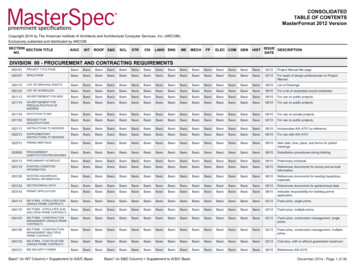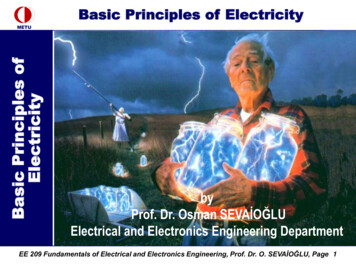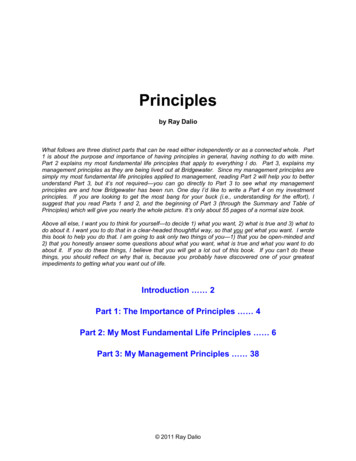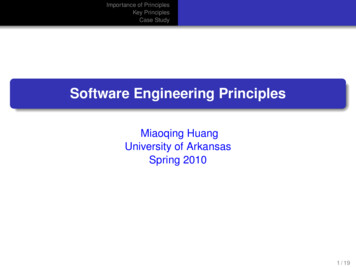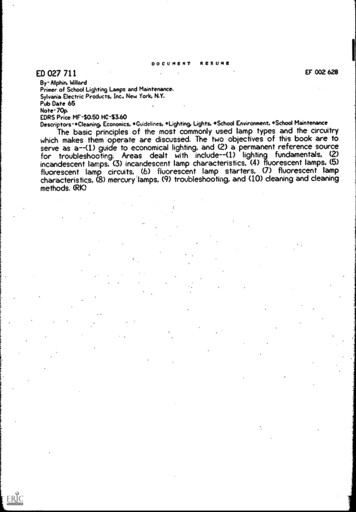
Transcription
DOCUMENTED 027 711RESUMEEF 002 628By- Allphin, WillardPrimer of School Lighting Lamps and Maintenance.Sylvania Electric Products, Inc., New York, N.Y.Pub Date 65Note- 70p.EDRS Price MF- 0.50 HC- 3.60Descriptors-sCleaning, Economics, *Guidelines, *Lighting, Lights, *School Environment, *School MaintenanceThe basic principles of the most commonly used lamp types and the circuitrywhich makes them operate are discussed. The two objectives of this book are toserve as a--(1) guide to economical lighting, and (2) a permanent reference sourcefor troubleshooting. Areas dealt with include--(1) lighting fundamentals, (2)incandescent lamps, (3) incandescent lamp characteristics, (4) fluorescent lamps, (5)fluorescent lamp circuits, (6) fluorescent lamp starters, (7) fluorescent lampcharacteristics, (8) mercury lamps, (9) troubleshooting. and (10) cleaning and cleaningmethods. (RK)
Primer ofSCHOOL LIGHTINGLAMPS AND MAINTENANCEU.S. DEPARTMENT OF HEALTH. EDUCATION & WRFARIOFFICE OF EDUCATIONTHIS DOCUMENT HAS REIN REPRODUCED EXACTLY AS RECEIVED 9014 THEPERSON OR ORGANIZATION ORIGINATING IT. POINTS OF VIEW OR OPINIONSSTATED DO NOT NECESSARILY REPRESENT OFFICiAl OFFICE OF EDUCATIONPOSITION OR POLICY.I
Primer ofSCHOOL LIGHTINGLAMPS AND MAINTENANCEWillard AllphinFellow of the Illuminating Engineering SocietyIllumination Research Engineer,Sylvania Electric Products Inc.SYLVAN IGTEAitISIDOIANY OFGENERALTELEPHONE & ELECTRONICS60 BOSTON ST., SALEM, MASS.
COPYRIGHT 1965 BYSYLVANIA ELECTRIC PRODUCTS INC.FIRST EDITIONAll Rights Reserved1i,,,"PleTISSION TO REPRODUCE THIS,COMM MATERIAL NAS KEN GRANTEDgy Tt41.14144oftv rRioiioIA1ZAllOSS OPERATINGUNDER ARNIM WM DE U.S. OffICE OfEDUCATION. NITER PIPIODUCTION OUTSIDETIE ERIC SYSTEM MOUSES PERMISSION OfIKE COPYMOIT OWNER."IPRINTED IN THE UNITED STATES OF AMERICABY THE PLIMPTON PRESS, NORWOOD, MASSACHUSETTS,.
AcknowledgmentsThanks are due to the U.S. Department of Health, Education andWelfare for permission to quote from its booklet "Organizing theMaintenance Program."Thanks also are due to Messrs. Samuel and Morris Feldman ofAetna Lighting Service Inc., Allston ( Boston), Massachusetts;Mr. Herbert Mendelsohn, Sun Ray Fluorescent Maintenance,Kansas City, Missouri; and Mr. Leon Mendelsohn, Steel CityFluorescent Maintenance, Inc., Chicago. They supplied helpfulinformation for this booklet.Information on lighting maintenance contractors in a particularcommunity can be obtained from NALMCO ( National Association of Lighting Maintenance Contractors), 2120 Keith Building,Cleveland, Ohio.
-,-.-. 110140 01RIliContentsACKNOWLEDGMENTSTo THE ADMINISTRATORV.XI1. A SHORT COURSE IN LIGHTING FUNDAMENTALS .1Voltage; Current; Power; Alternating Current;Power Factor; Three-Phase Supply2. INCANDESCENT LAMPS. .7Principles and Construction; Basic Principles;Blackening; Built-in Fuse; Bulb Finishes; Typesof Bases. .Effects of Voltage on Lamp Operation; DesignedLife of Incandescent Lamps; "Long Life" Lamps;3. INCANDESCENT LAMP CHARACTERISTICS.13.22Operation at Other Than Rated Voltage; GroupRelamping; Rough-Service and Vibration Lamps;Reflector Lamps; Indirect Reflector Lamps ( Silvered Bowl); Iodine Quartz Lamps4. FLUORESCENT LAMPS. .Operating Principles; Simple Preheat Circuit forFluorescent Lamps; Behavior of Arc; Phosphors;CircuitsVII
5. FLUORESCENT LAMP CIRCUITS.26Instant Start Circuits; High Output and VeryHigh Output Circuits; Grounding; Cold-CathodeLamps; Sizes of Fluorescent Lamps; BasesI6. FLUORESCENT LAmP STARTERS.7. FLUORESCENT LAMP CHARACTERISTICS30.32.IFactors Affecting Performance; Effect of Variation in Voltage; Effect of Starting on Life; LumenMaintenance; Group Replacement; Lamp Color;Reflector Lamps and Aperture Lamps8. MERCURY LAMPSi)1.9. TROUBLE-SHOOTING.38i1.39IIncandescent Lamps; Causes of Short Life; Com-plaints of Low Output; Fluorescent Lamps:Lamps Failing to Start; Short Life; End Darkening; Snaking; Ballast Noise; Failed Ballasts; Ballast Socket Kits; Mercury Lamps; RecommendedQuick-Reference Trouble-Shooting Chart10. CLEANING AND CLEANING METHODS.50i,VIII
.w.43.,Lad:.4 A good lighting system will stay that way only if a good lighting maintenance program is put into effect.*e 4*,411.111111'1
To the AdministratorMany school systems waste substantial sums of money everyyear through failure to get all the light they are paying for.Their investment in lighting equipment and electricity to operateit is primarily for the purpose of providing illumination on areassuch as desks, chalkboards, and tackboards. Whenever this illumination decreases substantially, money is wasted. The reduction in light output can be as high as 30 to 50 per cent, due todust and dirt on bulbs, fluorescent tubes and fixtures. Because ofthe even distribution of the dirt over the fixture, it can go unnoticed.Of course most school systems wash their lighting equipmenteach summer, but if this is not done thoroughly, they may startthe new season under a handicap. In fact, in some locations itmay be desirable to clean the equipment more than once a year.In addition to the light losses from dust and dirt, there is aloss when over-age bulbs and tubes are not replaced. Some lampslast much longer than their designed life, but do not deliverenough light to justify their continued use. An incandescent bulbwith considerable blackening, or a fluorescent tube with veryblack ends, should be thrown away because it is inefficient andhas outlived its usefulness.The decline in illumination, for whatever reason, is an insidiousthing. If a heating unit develops trouble and will only keep tberoom at 60 F. instead of 70 F., there is no doubt about the needfor immediate action. But the illumination in a room can fall offlittle-by-little without being noticed. Nevertheless, it may takemuch more effort for the pupils to see quickly and easily.xx
The Office of Education of the U.S. Department of Health,Education and Welfare says in its booklet "Organizing the Maintenance Program":"The problem of school plant maintenance begins on theday the school board accepts a building from the contractorand continues throughout the entire life of the building.Experience indicates that in far too many instances school))officials fail to recognize this fact. They seem to assume thata new building requires little or no maintenance until ithas been in use for several years. It is a mistake, sometimesa costly mistake, for school officials to permit maintenanceneeds to accumulate before they attempt to develop aplanned maintenance program. An adequate school plantmaintenance service is vitally important to the pupils, tothe educational program, and to the community, becausethe well-kept school building not only serves as a shelterand a school home for the pupils, but also as a tool of education and, frequently, the center of community life. It isessential that school plants be so operated and maintainedthat they provide optimum service. Adequately planned,well-built school buildings may be so operated and maintained that they fail to provide this service. On the otherhand, average or sometimes mediocre buildings may provide satisfactory service if they are properly operated .and1Iimaintained.""School plant people frequently complain that maintenanceis a stepchild of the school district when funds are beingallocated for various school services. This complaint is not,always without foundation, because school boards are oftenable to cut appropriations for maintenance without invokingmajor criticisms such as would be forthcoming if cuts weremade in appropriations for other essential school services.""In order to stimulate public interest in, and develop a deepconcern for, the significance of school plant maintenance itseems appropriate to suggest that school officials might perform an essential service by publicizing the advantages in-xn1
herent in a long-range, well-planned, adequately financedmaintenance program of the school district."**"Electrical services often become expensive because ofwasted current. Inefficient fixtures cause current waste; old,inefficient electric motors consume more current and deliverless power than new motors. Color of ceilings affects illumination levels. If the ceilings do not have the proper reflectance factor, or if they are dirty, they decrease the efficiencyof electric lights. In addition, electric lights often replace natural illumination because outside windows are not clean.The atmospheric soiling of glass over a month's period willimpede the transmission of light by as much as 25 per cent.This applies not only to window glass but also to glass fixtures used in connection with electric lights. An adequatemaintenance program will provide for the replacement ofinefficient fixtures and motors, correct ceiling conditions,and keep windows and light fixtures clean, thus eliminatingmuch waste in the use of electric current."No question about it, the nature of the problem requires thata specific program be followed if the greatest value is to be received for the money spent. It is the purpose of this booklet tosuggest some types of maintenance program and then go intosome detail about cleaning, relamping, and "trouble shooting."Just enough detail on lamp characteristics and circuitry is included to give custodians and maintenance men an understanding of lamps and their operation.Developing the Maintenance ProgramWhile school systems differ widely on their overall maintenancerequirements and their maintenance organization, every successful maintenance program must be properly planned and supervised and carried out by trained personnel.In systems where one crew handles plant operation and anotherhandles maintenance tasks, there is no agreement among schooladministrators as to which specific duties should be assigned toeach crew. Overall efficiency, labor costs, employee morale, sizeof school system and school board policy must all be taken intoconsideration. The organization of the work program varies too.
In some systems, one staff assistant may be responsible for bothplant operation and maintenance or separate crew supervisorsmay be preferable. In other systems, the same versatile crew mayperform both operations, with major maintenance jobs handledby outside companies. This of course makes possible a relativelysmaller permanent crew.In any case, the hiring of trained, experienced men is essentialif the program is to be carried out properly. If these are not ob-tainable, good workers should be selected who are willing toserve an apprenticeship to get adequate training on the job.The volume of work that must be performed will depend onthe size of the systemthe quality of the original equipment,and its age the intensity of use by school and non-school groupsand the effectiveness of supervision.There are three basic types of planned lighting maintenanceprograms used in school systems. In one type, cleaning, relamping and simple trouble shooting are done by the custodians.Electrical troubles involving ballasts, sockets, or circuits are refetred to an electrician who may be either inside or outside theschool system.The second type uses specialized maintenance men employedby the schools who work in teams, going from one school to another in the system. Sometimes a school department electricianalso is available.A few systems use a combination of the first two methods. Inthe summer, custodians leave their individual schools and become members of teams that travel fro:school to another.In this case, their maintenance work is nut limited to washinglighting fixtures, but includes floors, windows, furniture andother items.The third basic type of program is to contract the maintenanceof the lightning equipment to an outside lighting maintenancecontractor. This is not often done in public schools at present,but the practice is growing. A school system which adopts thepractice of doing the work with its own specialized crews is in aposition to determine if it would save money by using an outsideorganization. Information on such organizations can be obtainedfrom the National Association of Lighting Maintenance Contractors, 2120 Keith Building, Cleveland, Ohio.The influence of voltage on the life and light output of lampsparticularly incandescent will be discussed later in this book.XIV
However, administrative policy should be involved when lamplife is unduly short or long. ( As will be seen, unduly long lifemeans less light per dollar.) Because improper voltage greatlyaffects life, perhaps the voltage supplied to a school should bechanged, overloaded circuits corrected, or lamps of a differentvoltage rating purchased.Administrative policy concerning planned maintenance shouldembrace much more than merely cleaning lamps and fixtures inthe summer, if proper results are to be obtained. The administrator will need to lay out work schedules, set relamping policiesand prescribe washing methods. Check lists are useful tools insuch a program. Table I is an example of such a check list. Inaddition to such a check list an inventory which would give lamptypes and sizes and more detailed descriptions of the fixturesshould be kept by the Maintenance Supervisor for ready reference.TABLE ILIGHTING MAINTENANCE CHECK LISTName of SchoolFLUORESCENTFIXTURES!manCLEANINGdescent MercuryPlasticMetalShielding Shielding Fixtures Fixtures Wiped NashedAreaClassroom No. 1x12-647-65No. HomemakingArtxMusicxGymnasium8-65xxParking LotXV8-65!
To be of greatest possible help to the custodian, thisbooklet includes details on lamp characteristics andcircuitry. Of course, a custodian may only be conand perhaps fluorescentlamp starters. On the other hand, his supervisor mayneed to know about lamp characteristics affected byvoltage. An electrician doing maintenance work willbe familiar with general circuit problems, but may bein doubt about the differences between various fluorescent lamp and ballast circuits. Consequently, to begenerally useful, points will have to be covered whichwill seem elementary to some readers.cerned With replacing lampsxyl
Chapter 1A Short Course inLIGHTING FUNDAMENTALSVoltageif we wereThe volt is the electxic unit corresponding to pressuretalking about water in a pipe instead of electricity in a wire.Household voltage in the United States is most commonly frombecause115 to 120, but it is sometimes spoken of as "110 volts,"this used to be the common voltage.Actually, homes with sizeable electric loads have what isknown as 115/230 volt service, enfeting through a 3-wire cable.Between each outside wire and the "neutral" wire the voltage isin Figure 1, the115, but between the two "outside" wires, asvoltage is 230. This permits lamps, electric clocks, small applivolts availances, etc. to operate on 115 volts, while making 230able for large appliances such as electric ranges and air condi115/230 or 120/240tioners. Invariably schools are supplied withvolts unless they have only 3-phase service which will be discussed ison 3-wire electric service.Voltages are sometimes 120/240.Fig. 11
CurrentWhen voltage is applied to an electric circuit containing anylamp or appliance, a current flows through the circuit and throughthe device. Current is measured in amperes, or amps. for short.It is the current which determines the size of wire necessary toserve a load, because if the current is too great for the size ofthe wire, the wire will get hot. For example, under most circumstances No. 14 wire should not be required to carry more than15 amperes, so we put a 15 amp. fuse in the circuit. This containsa soft metal part which will melt and interrupt the circuit ifmore than 15 amperes flows for more than a moment or two.Sometimes a circuit breaker is used instead of a fuse. This opensan overload& circuit, but it can be reset when the overload isremoved. It does not need to be replaced as does a "blown" fuse.PowerElectric power is measured in watts, and 1000 watts 1 kilowatt (kw ). You can easily calculate the power in watts consumedby simple devices such as incandescent lamps and heating coils,by multiplying voltage times current. For example: if the socketvoltage is 115 and a heater draws a current of 12 amps., thepower is 115 x 12 1380 watts or 1.38 kilowatts. Kilowatts timeshours (kilowatt-hours ) are what you pay for on your electric bill.Incandescent lamps and heating coils are non-inductive devices. Fluorescent fixtures and induction motors are inductivedevices and, in such cases, power is not voltage times current,because of power factor, as will be explained later.Alternating CurrentWhen the starter switch in an automobile is closed, current fromthe storage battery flows through the wires to the starter motorand back to the battery. It flows in one direction only and iscalled direct current or d-c. There are other direct current devices, such as flashlights and battery-operated radios, but todaymost electrical devices and apparatus operate on alternating current, or a-c.In an a-c circuit, the voltage pushes first in one direction andthen the other. Each repetition of the process is called a cycleand a frequency or 60 cycles per second is almost universal in211
))1the United States. This means 120 reversals of direction per second, or the current flowing each way 80 times per second. In mostEuropean countries the frequency is 50 cycles.Edison's first lighting system used d-c, but when a-c was developed, it rapidly supplanted most of the d-c. The principal reason was that transformers can be used on a-c, but not on d-c. Atransformer is a simple device with no moving parts, which permits voltages to be "stepped up" and "stepped down" with verylittle loss in power.Why do we want to step voltage up or down? Remember thatpower equals voltage times current, that is, watts volts x amps.Therefore, for a given amount of power, whenever the voltagegoes up, the current comes down. Suppose we have a lcad of1,000 kw ( 1,000,000 watts ) at a place a mile away from thepower plant . . . if the power were transmitted at 120 volts, the 8330 amps. Remember also thatbcurrent would be lion-000the amount of current determines the size of wire necessary tocarry it. Wires big enough to carry more than 8,000 amps. wouldbe ridiculously and impractically large. On the other hand, if wegenerate the electricity at, say, 14,300 volts and transmit it to thecustomer at that voltage, the current will be only 1roll 70amps. This current can be carried by wires smaller than thoseentering the ordinary home. At the location of the load, a transformer steps the voltage down to 120/240 or some similar useablevoltage.For transmitting power over considerable distances, the voltage from the generators is actually stepped up, sometimes tomore than 100,000 volts, thus permitting very large amounts ofpower to be carried by small wires. It is the ability of transformers to step voltages up and down simply and efficiently, thatmakes much of our industrial development possible.Power FactorPower factor is a difficult subject, and no attempt at a completeexplanation can be given here. However, we shall say a littleabout its effects. As we have mentioned, incandescent lamps andheating devices are non-inductive loads; and the power they require can be calculated quite easily with a formula that is thesame for a-c circuits as for d-c circuits. That is :Volts x Amperes Watts311
I lowever, this is not the case in a-c circuits with inductiveloads such as induction motors and fluorescent lamps and theirin circuits serving inductive loads, the re-ballasts. The reasonversals in direction of voltage and current do not occur at thesame time. (They are not in phase.) This results in a loss ofpower. The power formula then becomes:Volts x Amperes X Power Factor WattsRearranging the formula:Amperes WattsVolts x Power FactorFor example, suppose we have a load of 1800 watts with apower factor of 60% ( or .60), on a circuit of 123 volts. The current will be:Am peres 1800120 x .6025If the power factor were 100% ( or 1.00), that is, if the currentand voltage were in phase, the current would be:Amperes 1800 15120 X 1Thus, it requires larger wires to serve the same load if the powerfactor is low. It might be better to by-pass the difficult subjectof power factor in it book of this type, except that it has animportant bearing on ballasts for fluorescent lamps. These comein both high power factor and low power factor types, althoughhigh power factor ballasts are used in leading makes of fixtures.To use low power factor ballasts in a fluorescent installationwould require substantially larger wires. An inductive load tendsto throw the current and voltage out of phase by making thecurrent alternations or reversals lag behind the voltage alternations. A capacitor tends to make the current lead the voltage inthe timing of their alternations. Therefore, a capacitor can beused to balance an inductive load in the same circuit, and resultin a high power factor for the combination. In the case of a highpower factor ballast, the condenser is built into the ballast.Three-Phase SupplyOne other explanation which will be attempted, without goinginto complete detail, is that of a three-phase supply. In Figure 2,one circuit is between wires A and B, one between B and C, and4
Fig. 2 Three-phase electric serviceanother between C and A. The important feature is that the alternations of current are not in phase in the three circuits. Whenthe current in one phase is at its maximum, the current in another is at less than half its maximum, and is increasing. The current in the third phase is at less than half its maximum, and isdecreasing. Thus, although each wire is a part of two circuits,the current it must carry is never double that of a single circuit.This means a considerable saving in wire for three-phase circuits as compared with single-phase circuits.Fig. 3 Three-phase service with neutral. Other voltagescan be used, but voltage across phases is always 1.73times the voltage from phase wire to neutral.5
Another type of three-phase circuit is shown in Figure 3. Thisis known as 3-phase, 4-wire, the middle wire being the neutralwire. The relative merits of three and four wires are quite technical, but in either case there is a substantial saving in copper ascompared with single phase. In industrial zones, both 3-phasepower circuits and single-phase lighting circuits are oftenbrought into large establishments. In such cases, the power circuits need not have as good regulation as the lighting circuits;that is, the voltage need not be held as constant by the electriccompany. In school neighborhoods, where separate circuits maynot be available and where the 3-phase power is well regulated,lighting circuits are taken off the power circuits by transformersas indicated in Figure 4.}PHASE WIRESNEUTRAL120 v 120 v.120 v20 vExample of lighting transformers connected fromphase wires to neutral of a 277/480 volt, 3-phase circuit.Fig. 4Lighting transformers that step the voltage down from 480 to120/240 volts could be used instead.6
Chapter 2INCANDESCENT LAMPSPrinciples and ConstructionWhen an electric current flows through a wire, the wire becomeswarmer. The rise in temperature is only slight if the wire hasplenty of capacity to carry the current ( that is, relatively littleresistance to the current flow ). If, on the other hand, the resistance of the wire is somehow increased, the heating can beenough to cause the wire to glow. A familiar example is the electric heater in which the heat comes from a glowing wire.Such a device has a self-governing effect. With any particularvoltage, a current flows through the wire and heats it. The heat-ing, in turn, increases the resistance of the wire, and this tendsto reduce the flow of current. Thus a point is reached quicklywhere no more current will flow unless the voltage is increased.As will be seen later, this is not true of a fluorescent lamp, whichwould "run away with itself' if an outside current-limiting devicewere not used.Basic PrinciplesThe glowing wire in an electric heater would not be very effectiveas a light source. If more voltage were applied and more currentwere forced through the coil, it would melt before it becamebright enough to give much light. What the inventors of the incandescent lamp did was to seal the filament wire into a glassbulb and pump out the air. In the absence of oxygen, the filamentcan be operated at a much higher temperature without "burning up."Many incandescent lamps have an inert gas instead of a vacuum inside the bulb. This enables the filament to be operated atstill higher temperatures, because the gas pressure slows downthe rate at which the metal slowly evaporates from the filament.7
As with the electric heating coil, the incandescent lamp is a selflimiting device and requires no auxiliary equipment. As someonedescribed it years ago, an incandescent lamp is essentially "apiece of wire in a bottle."Before the introduction of gas-filled lamps in 1913, all lampfilaments were operated in bulbs having a vacuum. In mostlamps today, gas is placed inside the bulb to introduce a pressure which reduces filament evaporation and permits a higherfilament temperature. The gas first used was nitrogen, Modernlamps use a mixture of argon and nitrogen in amounts that depend on the wattage. Argon and nitrogen are inert gases which donot combine chemically with tungsten. They are introduced intothe bulb at about 80 per cent of atmospheric pressure, but thepressure rises to approximately atmospheric when the lamp isoperated at normal voltage.Nearly all lamps smaller than 40 watt and some larger ones areof the vacuum type. The others are gas-filled lamps. Vacuumlimps are designated as Class B, and gas-filled lamps are designated as Class C in catalogs and price schedules.Figure 5 shows common bulb Parabolic PearTubularStraight NeckReflector1T (Lumiline Type)1-3 (Iodine Quartz)Fig. 5 Common bulb shapes81
BlackeningAs a result of normal evaporation of the filament, tungsten particles are deposited on the inner surface of a lamp bulb. The bulbthus becomes blackened. In a vacuum lamp, the blackening occurs rather evenly over the entire inside of the bulb. In a gasfilled lamp, convection currents set up in the hot gas carry theparticles of tungsten upward. Thus they are deposited on thebowl when the lamp is burning base down, or on the neck whenthe lamp is burning base up.In most vacuum lamps, an active material known as a "getter"is applied to the filament or leads during manufacture to reduceresidual gas pressure and to clear up the atmosphere when thelamp is first lighted. In such a vacuum lamp the getter ma-terially reduces blackening. Blackening due to evaporation of thefilament is responsible for most of the decline of light output during the life of a lamp. The change in light output ( or lumen output) is called "lumen maintenance" or sometimes just "mainte-nance." Do not confuse it with the maintenance that refers tocleaning lamps and fixtures.Built-ln FuseFew people realize that most of the lamps they buy have built-infuses. If a filament breaks while a lamp is lighted, an arc couldform across the break and draw a much heavier current than thelamp was designed for. The fuse is a part of one lead-in wire.Under an abnormal current such as just described, the fuse willopen and protect the lamp and circuit from excessive current.Bulb FinishesThe standard bulb finishes are clear, inside-frosted, daylight(clear and inside-frosted), white-bowl, silvered-bowl, inside-reand natflector, inside-colored, outside-colored, white ceramic,ural-colored glass.of allAn inside-frosted finish, which is by far the most commonbulb finishes, spreads the brilliant filament image and partiallydiffuses the light. This finish reduces glare when bare lamps areused, and minimizes shadows and bright streaks when lamps areused in lighting fixtures.Daylight lamps produce a light that is more nearly like daylight in color by the use of blue-glass bulbs which absorb some9
of the red and yellow wave lengths. This absorption results in aloss in lamp efficiency of approximately 35 per cent. A good ruleto remember here is that it takes the next larger wattage size ofdaylight to supply the same quantity of light as the inside-frostedlamp being replaced. In other words, a 300 watt daylight lamphas approximately the same lumen output as a 200 watt insidefrosted lamp.White-bowl lamps are made by spraying a white diffusing)II1iItenamel on the inside of the bowl, opposite the base, to directabout 80 per cent of the light upward and 20 per cent throughthe bowl. These lamps are often used in open-type industrial reflectors for direct lighting to lessen glare and soften shadows.iTypes of BasesThe base of an incandescent lamp performs two very importantfunctions. First, it holds the lamp firmly in the socket in the electrical circuit. Second, it conducts the electricity from the circuitto the lead-in wires of the lamp. For most applications, lampsTABLE 11VARIOUS INCANDESCENT LAMP BASESBASE TYPETYPICAL LAMP USING THIS BASEMini-can screwCandelabraIntermediateMedium250-w, T-4, Super Q IodineQuartz7-w, C-7, Night LightMogul10-w, S-11, Sign100-w, A-19300-w, PS-35150-w, PAR-38, Projector50-100-150w, PS-25, Three-lite300-w, PS-30Three contact mogul100-200-300-w, PS-25,Medium skirted (cement)Medium skirted (mechanical)Three contact mediumIndirect Three-liteMedium prefocusMogul prefocusDouble-contact bayonet candelabraDiscRecessed single contactRectangular recessed single contact10500-w, T-10, Projection1000w, G-40, Spotlight25-watt, T-8, Home Appliance40-w, T-8, Lumiline300-w, T-4, Iodine Quartz100
EDRS Price MF- 0.50 HC- 3.60 Descriptors-sCleaning, Economics, *Guidelines, *Lighting, Lights, *School Environment,*School Maintenance. The basic principles of the most commonly used lamp types and the circuitry which makes them operate are discussed.



